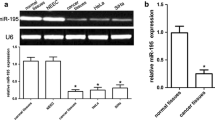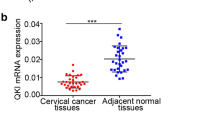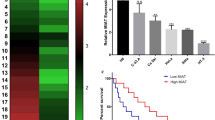Abstract
Cervical cancer (CC) is one of the most frequently diagnosed tumors in female. miR-122 has been proved to be dominant in CC. The particular role of miR-122 in CC is unclear. Thus, we attempted to investigate the prognostic role of miR-122 in CC. We used the database of Kaplan–Meier curve plot. Growth and apoptosis of C33A cells were detected by CCK-8, colony formation assay, transwell assays and flow cytometry analysis. The target gene of miR-122 was identified using bioinformatics, q-PCR, western blot and luciferase assay. It showed that CC patients with overexpression of miR-122 have a better prognosis in the Kaplan–Meier plot database analysis. Overexpressed miR-122 inhibited the malignant growth and induced apoptosis of CC. miR-122 targeting of RAD21 cohesin complex component (RAD21) was identified using bioinformatics, Q-PCR, western blot and luciferase assay analyses. Moreover, we found miR-122 conduct its functions via RAD21 via the PI3K/AKT signaling pathway. Importantly, overexpression of RAD21 restored the roles of miR-122 in CC. Our data suggested that miR-122 could block malignant growth and promoted apoptosis by targeting RAD21 in CC. Our finding indicates miR-122 could potentially participate in the pathogenesis and be a biomarker or the potential therapeutic target of CC.




Similar content being viewed by others
Data Availability
All primary data presented in this study are available from the corresponding author upon reasonable request.
References
Ahn JH, Kim TJ, Lee JH, Choi JH (2018) Author correction: mutant p53 stimulates cell invasion through an interaction with Rad21 in human ovarian cancer cells. Sci Rep 8(1):11032
Birkenbihl RP, Subramani S (1995) The rad21 gene product of Schizosaccharomyces pombe is a nuclear, cell cycle-regulated phosphoprotein. J Biol Chem 270(13):7703–7711
Bisaillon R, Moison C, Thiollier C, Krosl J, Bordeleau ME, Lehnertz B, Lavallee VP, MacRae T, Mayotte N, Labelle C et al (2020) Genetic characterization of ABT-199 sensitivity in human AML. Leukemia 34(1):63–74
Cai J, Li B, Zhu Y, Fang X, Zhu M, Wang M, Liu S, Jiang X, Zheng J, Zhang X et al (2017) Prognostic biomarker identification through integrating the gene signatures of hepatocellular carcinoma properties. EBioMedicine 19:18–30
Chen J, Deng Y, Ao L, Song Y, Xu Y, Wang CC, Choy KW, Tony Chung KH, Du Q, Sui Y et al (2019a) The high-risk HPV oncogene E7 upregulates miR-182 expression through the TGF-beta/Smad pathway in cervical cancer. Cancer Lett 460:75–85
Chen Y, Du J, Wang Y, Shi H, Jiang Q, Wang Y, Zhang H, Wei Y, Xue W, Pu Z et al (2019b) MicroRNA-497-5p induces cell cycle arrest of cervical cancer cells in S phase by targeting CBX4. OncoTargets Ther 12:10535–10545
Chen F, Kamradt M, Mulcahy M, Byun Y, Xu H, McKay MJ, Cryns VL (2002) Caspase proteolysis of the cohesin component RAD21 promotes apoptosis. J Biol Chem 277(19):16775–16781
Chiantore MV, Vannucchi S, Accardi R, Tommasino M, Percario ZA, Vaccari G, Affabris E, Fiorucci G, Romeo G (2012) Interferon-beta induces cellular senescence in cutaneous human papilloma virus-transformed human keratinocytes by affecting p53 transactivating activity. PLoS ONE 7(5):e36909
Ding FN, Gao BH, Wu X, Gong CW, Wang WQ, Zhang SM (2019) miR-122-5p modulates the radiosensitivity of cervical cancer cells by regulating cell division cycle 25A (CDC25A). FEBS Open Bio 9(11):1869–1879
Duran-Sanchon S, Moreno L, Auge JM, Serra-Burriel M, Cuatrecasas M, Moreira L, Martin A, Serradesanferm A, Pozo A, Costa R et al (2019) Identification and validation of microRNA profiles in fecal samples for detection of colorectal cancer. Gastroenterology 158(4):947-957.e4. https://doi.org/10.1053/j.gastro.2019.10.005
Fan Y, Chen J (2017) Clinicopathological significance of survivin expression in patients with cervical cancer: a systematic meta-analysis. Bioengineered 8(5):511–523
Gadducci A, Barsotti C, Cosio S, Domenici L, Riccardo Genazzani A (2011) Smoking habit, immune suppression, oral contraceptive use, and hormone replacement therapy use and cervical carcinogenesis: a review of the literature. Gynecol Endocrinol 27(8):597–604
Gao C, Zhou C, Zhuang J, Liu L, Liu C, Li H, Liu G, Wei J, Sun C (2018) MicroRNA expression in cervical cancer: novel diagnostic and prognostic biomarkers. J Cell Biochem 119(8):7080–7090
Hauf S, Waizenegger IC, Peters JM (2001) Cohesin cleavage by separase required for anaphase and cytokinesis in human cells. Science 293(5533):1320–1323
He J, Ji Y, Li A, Zhang Q, Song W, Li Y, Huang H, Qian J, Zhai A, Yu X et al (2014) MiR-122 directly inhibits human papillomavirus E6 gene and enhances interferon signaling through blocking suppressor of cytokine signaling 1 in SiHa cells. PLoS ONE 9(9):e108410
Jiang Z, Song Q, Zeng R, Li J, Li J, Lin X, Chen X, Zhang J, Zheng Y (2016) MicroRNA-218 inhibits EMT, migration and invasion by targeting SFMBT1 and DCUN1D1 in cervical cancer. Oncotarget 7(29):45622–45636
Jones WB, Mercer GO, Lewis JL Jr, Rubin SC, Hoskins WJ (1993) Early invasive carcinoma of the cervix. Gynecol Oncol 51(1):26–32
Lin Y, Zhou J, Dai L, Cheng Y, Wang J (2017) Vaginectomy and vaginoplasty for isolated vaginal recurrence 8 years after cervical cancer radical hysterectomy: a case report and literature review. J Obstet Gynaecol Res 43(9):1493–1497
Liu SS, Chan KKL, Chu DKH, Wei TN, Lau LSK, Ngu SF, Chu MMY, Tse KY, Ip PPC, Ng EKO et al (2018) Oncogenic microRNA signature for early diagnosis of cervical intraepithelial neoplasia and cancer. Mol Oncol 12(12):2009–2022
Mao Y, Shen G, Su Z, Du J, Xu F, Yu Y (2019) RAD21 inhibited transcription of tumor suppressor MIR4697HG and led to glioma tumorigenesis. Biomed Pharmacother 123:109759
Panigrahi AK, Pati D (2009) Road to the crossroads of life and death: linking sister chromatid cohesion and separation to aneuploidy, apoptosis and cancer. Crit Rev Oncol Hematol 72(3):181–193
Pati D, Zhang N, Plon SE (2002) Linking sister chromatid cohesion and apoptosis: role of Rad21. Mol Cell Biol 22(23):8267–8277
Peta E, Sinigaglia A, Masi G, Di Camillo B, Grassi A, Trevisan M, Messa L, Loregian A, Manfrin E, Brunelli M et al (2018) HPV16 E6 and E7 upregulate the histone lysine demethylase KDM2B through the c-MYC/miR-146a-5p axys. Oncogene 37(12):1654–1668
Sadri Nahand J, Moghoofei M, Salmaninejad A, Bahmanpour Z, Karimzadeh M, Nasiri M, Mirzaei HR, Pourhanifeh MH, Bokharaei-Salim F, Mirzaei H et al (2020) Pathogenic role of exosomes and microRNAs in HPV-mediated inflammation and cervical cancer: a review. Int J Cancer 146(2):305–320
Sun Q, Yang Z, Li P, Wang X, Sun L, Wang S, Liu M, Tang H (2019) A novel miRNA identified in GRSF1 complex drives the metastasis via the PIK3R3/AKT/NF-kappaB and TIMP3/MMP9 pathways in cervical cancer cells. Cell Death Dis 10(9):636
Supernat A, Lapinska-Szumczyk S, Sawicki S, Wydra D, Biernat W, Zaczek AJ (2012) Deregulation of RAD21 and RUNX1 expression in endometrial cancer. Oncol Lett 4(4):727–732
Tran NP, Hung CF, Roden R, Wu TC (2014) Control of HPV infection and related cancer through vaccination. Viruses Hum Cancer 193:149–171
Uhlmann F, Wernic D, Poupart MA, Koonin EV, Nasmyth K (2000) Cleavage of cohesin by the CD clan protease separin triggers anaphase in yeast. Cell 103(3):375–386
Waggoner SE (2003) Cervical cancer. Lancet 361(9376):2217–2225
Wang S, Gao B, Yang H, Liu X, Wu X, Wang W (2019) MicroRNA-432 is downregulated in cervical cancer and directly targets FN1 to inhibit cell proliferation and invasion. Oncol Lett 18(2):1475–1482
Wang M, Yu W, Gao J, Ma W, Frentsch M, Thiel A, Liu M, Rahman N, Qin Z, Li X (2020) MicroRNA-487a-3p functions as a new tumor suppressor in prostate cancer by targeting CCND1. J Cell Physiol 235(2):1588–1600
Wei WF, Zhou CF, Wu XG, He LN, Wu LF, Chen XJ, Yan RM, Zhong M, Yu YH, Liang L et al (2017) MicroRNA-221-3p, a TWIST2 target, promotes cervical cancer metastasis by directly targeting THBS2. Cell Death Dis 8(12):3220
Xia L, Wang M, Li H, Tang X, Chen F, Cui J (2018) The effect of aberrant expression and genetic polymorphisms of Rad21 on cervical cancer biology. Cancer Med 7(7):3393–3405
Xu H, Balakrishnan K, Malaterre J, Beasley M, Yan Y, Essers J, Appeldoorn E, Tomaszewski JM, Vazquez M, Verschoor S et al (2010) Rad21-cohesin haploinsufficiency impedes DNA repair and enhances gastrointestinal radiosensitivity in mice. PLoS ONE 5(8):e12112
Xu H, Tomaszewski JM, McKay MJ (2011) Can corruption of chromosome cohesion create a conduit to cancer? Nat Rev Cancer 11(3):199–210
Yamamoto G, Irie T, Aida T, Nagoshi Y, Tsuchiya R, Tachikawa T (2006) Correlation of invasion and metastasis of cancer cells, and expression of the RAD21 gene in oral squamous cell carcinoma. Virchows Arch 448(4):435–441
Yin S, Fan Y, Zhang H, Zhao Z, Hao Y, Li J, Sun C, Yang J, Yang Z, Yang X et al (2016) Differential TGFbeta pathway targeting by miR-122 in humans and mice affects liver cancer metastasis. Nat Commun 7:11012
Yin S, Yang M, Li X, Zhang K, Tian J, Luo C, Bai R, Lu Y, Wang M (2020) Peripheral blood circulating microRNA-4636/-143 for the prognosis of cervical cancer. J Cell Biochem 121(1):596–608
Yu C, Qian L, Uttamchandani M, Li L, Yao SQ (2015) Single-vehicular delivery of antagomir and small molecules to inhibit miR-122 function in hepatocellular carcinoma cells by using “smart” mesoporous silica nanoparticles. Angew Chem 54(36):10574–10578
Yu Z, Xu Q, Wang G, Rowe M, Driskell C, Xie Q, Wu M, Jia D (2019) DNA topoisomerase IIalpha and RAD21 cohesin complex component are predicted as potential therapeutic targets in bladder cancer. Oncol Lett 18(1):518–528
Acknowledgements
Not applicable.
Funding
This work was supported by Grants from Jiangsu Province Maternal and Child Health Research Project No. F20013492; Xuzhou Science and Technology Bureau No. KC9138.
Author information
Authors and Affiliations
Contributions
Conception and design: HS; acquisition of data: HS; analysis and interpretation of data: YY, YL; writing, review, and/or revision of the manuscript: YY, YL, HS; administrative, technical, or material support: WL, CL, YL, WH; study supervision: HS.
Corresponding author
Ethics declarations
Conflict of interest
The authors declare no conflict of interest.
Ethical Approval
All the research procedures strictly followed the REMARK and ethical review boards of Xuzhou Maternal and Child Health Hospital affiliated to Xuzhou Medical University.
Informed Consent
All authors have confirmed the publication.
Additional information
Publisher's Note
Springer Nature remains neutral with regard to jurisdictional claims in published maps and institutional affiliations.
Rights and permissions
About this article
Cite this article
Yang, Y., Liu, Y., Liu, W. et al. miR-122 Inhibits the Cervical Cancer Development by Targeting the Oncogene RAD21. Biochem Genet 60, 303–314 (2022). https://doi.org/10.1007/s10528-021-10098-z
Received:
Accepted:
Published:
Issue Date:
DOI: https://doi.org/10.1007/s10528-021-10098-z




